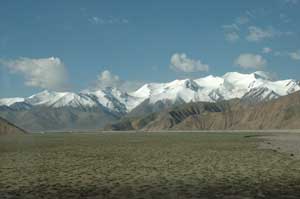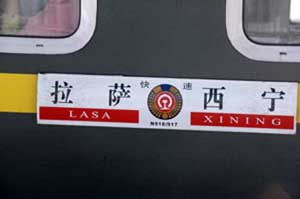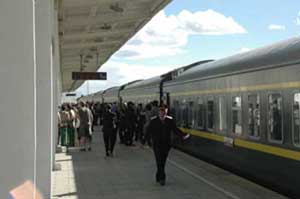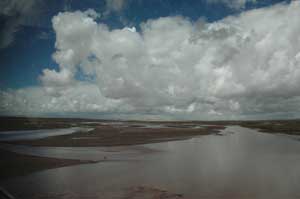
The Bird’s Word Blog
Taking the Train to Lhasa, Tibet

Lhasa, Tibet is accessible by road, air and rail, provided you can get the permits, reservations or vehicles to make the journey. I had been to Tibet on three previous occasions since 1986 using some combination of air and road travel, but the train trip sounded like a good way to see a great deal of the Tibetan Plateau than the road or air routes.


I had just led a group to witness the Total Solar Eclipse of Aug 1, 2008, near Hami in Western China. Four of us from that group flew to Lanzhou where we caught the train to Xining station and began our 27 hour journey to Lhasa. While the rail line exists for many reasons, catering to foreign tourists does not seem to be high on the list. On the day we traveled, there were only 10 foreigners all confined to one car in which none of the conductors or other staff spoke any English. While there were promotional videos, they had little to do with the train and the sound track was in Mandarin. The electronic text crawl sign in the corridor of our ”soft sleeper” car in which we traveled consistently mis-named the stops and the expected time between stations. It was often not clear how long the train would be stopped between stations and whether it was possible or advisable to get off.
While the cars and the bedding where clean, there was very little luggage storage space within the small four-berth cabins, and none at all outside of the cabin. This meant that two of the people in our cabin with large luggage had to share the microberths with large bags. Upper berths had no visibility out of the one window in the compartment.
Sleeping car was adjacent to a dining car which had large windows. It was a much more pleasant place to sit than either our sleeper or the non-sleeper coach. The several hundred Chinese passengers on the train included a very high percentage of smokers and outside of our non-smoking sleeper, the air was blue with smoke. This smoke seemed to permeate all areas of the train via the ventilation system. The dining car served relatively expensive, but mediocre food. My first meal was breakfast which consisted almost entirely of thin gruel and cold, pickled and fermented vegetables. There was no menu in English. If you travel this train, bring your own food. Lunch and dinner were only marginally better and the beer was warm. The cost and quality of the food meant that not many people actually ate in the dining car, but during dining hours table reservations were still required. During other hours we kept getting chased out of the dining car because there were “staff meetings”. These seemed better described as staff naps.
The train ride was very smooth and quiet and the views were fantastic. We saw numerous herds of chiru or Tibetan Antelope. Herds of yak, high lakes, eagles, ravens and hundreds of snow covered peaks provided an evolving panorama of beauty. We passed through several long tunnels and the train gained altitude to (supposedly) over 16,600′ at Tangulla Pass, the highest rail point in the world, though we passed this point unceremoniously and without acknowledgement.


Before we departed the station in Xining, we were required to complete a medical form which seemed oriented at identifying passengers who might find difficulty with the altitude. We were asked detailed questions about heart and blood pressure, diseases and medications we were taking. This all seemed quite responsible except that no one could speak or read the English answers we provided. We had been told that oxygen was provided as a courtesy in all the sleepers and this was reassuring, but there were no masks or fittings for the oxygen valves. Several of us developed headaches and the altitude served to make the bad food even less attractive, but we did not suffer greatly or have serious problems from the altitude.
We arrived into the Lhasa station about 10:30 PM. I was surprised by how many hundreds of people disembarked. There was nothing friendly or welcoming about Lhasa station. There were scores of uniformed and armed security people who formed a gauntlet through which passengers dragged their luggage. There was no porterage assistance available an no baggage carts. A curfew was in effect and we were told that it was necessary to travel directly to our hotel. The city was very quiet and the streets eerily empty.
On balance it was an interesting trip which offered a view of Tibet with no opportunity to interact. The train was operated safely and capably, but with no evident effort to demonstrate personal passenger service. Every one was doing their job, and not a bit more. Given the choice of taking the train or having an flown to Lhasa and taking an extra day to travel in the Tibetan countryside by private taxi, I think I would have chosen the plane and taxi.

Design an adventure with Journeys International!
With over 40 years of experience, we create experiences that match your goals.
Start Planning

